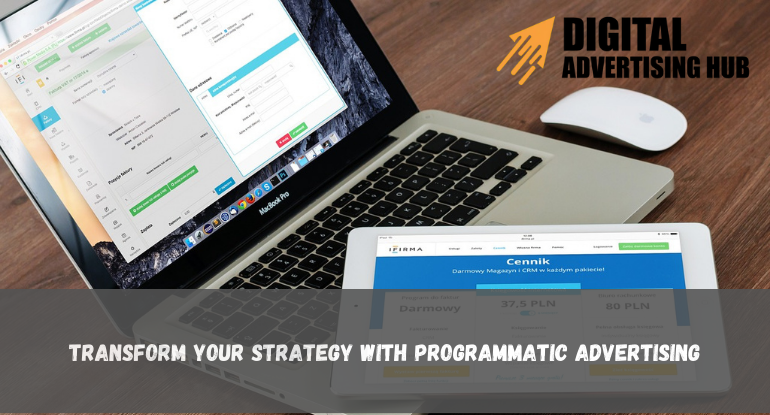Advertising these days isn’t like it used to be. It’s not just about putting up billboards or airing commercials on TV anymore. There’s this new way called programmatic advertising that’s causing a stir.
Imagine it like this: it’s a super-smart tool that helps companies connect with exactly the people they want to talk to.
Instead of guessing who might be interested in their stuff, businesses can use programmatic ads to target specific groups. This helps them reach the right folks at the right time. It’s like having a secret weapon for marketing
Let’s delve into the world of programmatic advertising and explore how it can revolutionize your marketing strategy.
What is Programmatic Advertising?

Programmatic advertising revolutionizes ad space transactions through automated algorithms and data-driven mechanisms. In contrast to traditional approaches reliant on manual negotiations, this method harnesses technology to swiftly analyze consumer actions.
It optimizes ad display, ensuring relevance by targeting specific audiences with precision timing across diverse platforms. By eliminating manual processes, programmatic advertising enhances efficiency and accuracy in delivering tailored advertisements.
This system’s core lies in its capacity to swiftly adapt, utilizing real-time insights to present ads to the most fitting audience segments. It marks a shift from conventional methods, employing a dynamic framework that maximizes advertisement impact while minimizing wasted exposure.
How Does it Work?
The process of programmatic advertising unfolds through several key steps, each playing a pivotal role in its seamless operation.
#1. Data Aggregation and Analysis: The process of data aggregation and analysis in programmatic advertising initiates by gathering a vast spectrum of user information, encompassing a multitude of aspects.
This expansive collection includes intricate details such as how users navigate the web, their preferences, demographics like age, location, and gender, and even nuanced individual interests.
This amassed reservoir of data forms the foundational cornerstone, acting as the primary building blocks for the subsequent steps in the advertising process. It’s not just about collecting information for the sake of it; rather, it’s about mining these insights to craft meticulously tailored ad experiences.
Every click, every scroll, and every interaction contributes to this mosaic of user behavior. It’s about understanding the subtleties of their online journey, piecing together a comprehensive profile that paints a vivid picture of who they are and what they seek.
This rich tapestry of data becomes the canvas upon which personalized and targeted ad campaigns are artfully designed, ensuring relevance and resonance with each unique user.
#2. Real-Time Bidding Dynamics: The intricate mechanism of real-time bidding in programmatic advertising unfurls swiftly when a user navigates to a website. Almost instantaneously, a high-speed auction commences, operating within mere milliseconds.
This rapid-fire auction pits advertisers against each other in a competitive frenzy, vying for the chance to secure available ad spaces that align with the user’s profile.
Within this lightning-paced environment, advertisers harness the wealth of user profile data collected earlier in the process. This invaluable information serves as the guiding compass for their bidding strategies.
They leverage insights garnered from the user’s browsing history, demographics, and behavior to make informed and strategic bids, aiming to outmaneuver competitors and secure the prime ad space that best fits the targeted audience’s preferences and characteristics.
This real-time bidding dance is not merely about who bids the highest; it’s a strategic tango where precision and agility play crucial roles. Advertisers strategize, adjusting bids on the fly to optimize their chances of winning the ad placement that perfectly aligns with their target audience.
It’s a dynamic battlefield where split-second decisions are made based on nuanced user data, determining which ad gets the coveted spotlight for that specific user at that precise moment.
#3. Instantaneous Ad Selection: The culmination of this rapid bidding frenzy results in the determination of the winning bid. This victorious bid paves the way for the display of the most pertinent and contextually fitting advertisement to the user, aligning precisely with their preferences and characteristics.
#4. Dynamic Ad Placement: This meticulous process ensures that the displayed ad resonates profoundly with the individual’s profile, ensuring relevance and resonance.
Through this dynamic placement strategy, programmatic advertising maximizes engagement potential by delivering ads precisely when and where they hold the most significance for the user.
#5. Continuous Adaptation and Optimization: Furthermore, programmatic advertising isn’t static. It continuously evolves, leveraging real-time data and analytics to refine its strategies.
This adaptive nature allows for ongoing optimization, ensuring that ads maintain their relevance and efficacy amidst the ever-changing landscape of consumer behavior and trends.
#7. Efficiency and Streamlined Operations: The beauty of this system lies in its efficiency, sparing advertisers the cumbersome manual processes involved in traditional ad placement.
Programmatic advertising, through its automated approach, optimizes the entire process, making it swifter, more accurate, and markedly more efficient.
Benefits of Programmatic Advertising

Programmatic advertising is a game-changer in the marketing landscape, offering a myriad of advantages that redefine how advertisers connect with their audience and optimize their campaigns.
#1. Pinpoint Precision Targeting: This method allows advertisers to delve deep into user data, unlocking insights into demographics, behaviors, and interests.
Armed with this information, ads are precisely tailored to reach the most receptive audience segments. It’s not just about reaching more people; it’s about reaching the right people, thereby significantly boosting engagement and conversion rates.
#2. Dynamic Real-Time Optimization: One of its most compelling features is the ability to adapt on the fly. Campaigns aren’t static; they’re dynamic entities that can be tweaked instantly based on real-time performance metrics.
This agility ensures that advertising efforts remain finely tuned, maximizing their impact and relevance at any given moment.
#3. Cost Efficiency and Streamlined Operations: Automation is a key driver here. By reducing manual intervention, programmatic advertising slashes operational costs while maintaining or even enhancing campaign effectiveness.
The streamlined processes allow for better resource allocation, ensuring that every advertising dollar is optimized for maximum returns.
#4. Expanded Reach and Scale: The breadth of this approach is staggering. It’s not confined to a single channel or format; rather, it spans across diverse ad formats and multiple channels.
This expansive reach translates to increased exposure and a broader footprint across various platforms, significantly amplifying brand visibility and engagement opportunities.
#5. Granular Performance Insights: Programmatic advertising isn’t just about reaching audiences; it’s about understanding how they engage. The data generated provides rich insights into campaign performance, allowing for granular analysis.
This detailed understanding enables continual refinement and optimization, ensuring that future campaigns are even more effective.
#6. Personalized User Experiences: Beyond just targeting, programmatic advertising enables the creation of highly personalized experiences. Tailored messages resonate more deeply with audiences, fostering stronger connections and brand loyalty.
#7. Adaptable and Future-Proof: The digital landscape evolves rapidly, but programmatic advertising adapts. Its adaptable nature ensures it remains relevant in an ever-changing environment, staying ahead of trends and technological advancements.
Transforming Your Strategy
Incorporating programmatic advertising into your marketing blueprint has the potential to revolutionize your approach, injecting a new level of precision and efficacy. Here’s a comprehensive breakdown of how this integration can redefine your strategy:
#1. Data-Driven Audience Understanding: Embrace the power of data analytics to unravel intricate insights about your audience. Dive deep into demographics, behaviors, and preferences.
This profound understanding forms the cornerstone for crafting highly targeted and personalized campaigns, resonating deeply with individual preferences and characteristics.
#2. Strategic Blueprinting: Develop a robust roadmap outlining clear campaign objectives, delineating the target audience, and establishing concrete Key Performance Indicators (KPIs).
This strategic groundwork serves as a guiding light, ensuring that every campaign element aligns harmoniously with overarching goals, fostering precision and coherence.
#3. Expert Collaboration: In this intricate realm of programmatic advertising, seeking guidance from seasoned professionals or specialized agencies can be a game-changer.
Their expertise not only demystifies the complexities but also unveils untapped potentials. Collaborating with these experts ensures a smoother navigation through this intricate landscape, unlocking its full potential.
#4. Iterative Monitoring and Optimization: The journey doesn’t end with campaign launch; it thrives on continual evolution. Regularly monitor campaign performance with an eagle eye. Analyze metrics, decipher patterns, and promptly pivot strategies as needed.
This iterative approach to optimization ensures that your campaigns remain agile and adaptive, consistently maximizing their impact and effectiveness.
#5. Adaptive Learning Culture: Embrace a culture of constant learning and adaptation. The insights gained from each campaign iteration are invaluable. Incorporate these learnings into future strategies, perpetually refining and enhancing your approach.
#6. Agility in Response: Flexibility is key. In the dynamic landscape of programmatic advertising, being nimble in response to market shifts and emerging trends is crucial. Adapt swiftly to capitalize on new opportunities and remain at the forefront of innovation.
#7. Long-Term Strategy Development: While immediate results matter, programmatic advertising also demands a long-term vision. Cultivate a strategic approach that balances short-term wins with sustained, overarching objectives, ensuring consistent growth and brand resonance.
Conclusion
Programmatic advertising offers a powerful way to amplify your marketing efforts, providing a level of precision and efficiency that traditional methods often lack.
By harnessing the capabilities of this technology and integrating it strategically into your marketing approach, you can reach your target audience more effectively, drive engagement, and achieve better returns on your advertising investment.
In a constantly evolving digital world, embracing the possibilities of programmatic advertising can significantly elevate your brand’s visibility and impact in the market. Embrace this shift, and transform your marketing strategy today





